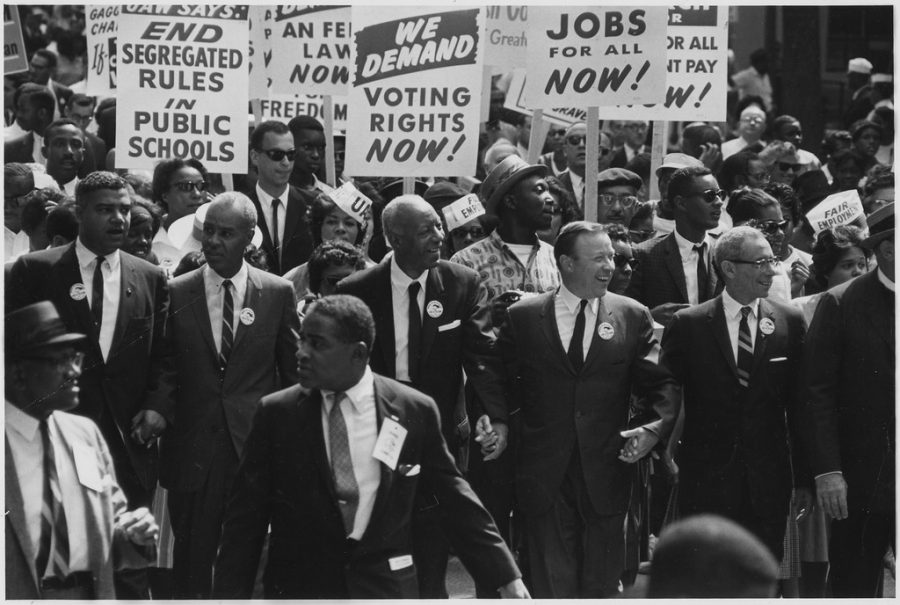Ceesay: Critical race theory should be used to dismantle systemic racism
Rowland Scherman, Public domain, via Wikimedia Commons
Critical race theory reconstructs how African American history is depicted in schools.
November 17, 2021
Early this month, I watched former U.S. Secretary of State Condoleeza Rice advocate against critical race theory on the talk show “The View.” She did not believe it needed to be implemented in schools because it would make white children feel ashamed of their race.
Critical race theory, however, is almost imperative in American school systems. Because there is a lack of instruction about African American history, students fail to see how we have been greatly impacted by the structures U.S. society and government has put in place for us. In fact, only 8 percent of U.S. high schoolers could identify slavery as the cause of the Civil War. If only a very small number of students can identify slavery’s impact outside of the African American history, how could they be aware of its long-term effects on African Americans?
This alone demonstrates a need for critical race theory. The U.S. has intentionally ignored how many events have forcibly placed African Americans beneath white Americans in society; however, with critical race theory, the U.S. can work toward obtaining the level of equality many people mistakenly believe we have already achieved.
Additionally, Rice’s statement embodies what so many people fail to see about critical race theory and race relations in America: Its purpose is not to teach about how white Americans are villains in society, but how African Americans have been affected by systemic racism since our ancestors journeyed across the Middle Passage. Rice’s comment also illustrates a key issue at hand: how white Americans and their best interests are prioritized over any other group’s, though they are not the people who have been affected.
Throughout school, I never learned about significant events in African American history, such as the Tulsa Race Massacre, Mississippi’s own hanging bridge or how the cycle of poverty primarily affects African Americans. Frankly, I didn’t learn about our history beyond slavery and the Civil Rights Movement until I was in the seventh grade. One study conducted by the National Council for the Social Studies reported an average history class in the U.S. only dedicates 8-9% of its lessons to Black history. The lack of African American history in schools’ history lessons only confirms what the dismissal of critical race theory already has shown: that African American history is unimportant because teaching about it just barely disadvantages white Americans.
As of August, 12 states have passed legislation to ban critical race theory, and 27 have initiated certain processes to prevent it from being taught. Some states defended their bans by stating it would cause division between students and stating – like Rice believes – it will cause white students to feel guilty.
Critical race theory can be defined as a body of work that will reconstruct how African American history is depicted within schools. It aims to do so by showing how race has affected the execution of racial justice, particularly amongst African Americans. Our school systems need to use critical race theory to work toward improving racial issues amongst African Americans. It will finally give full transparency on how practices like slavery have negatively impacted our advancement within society and how these lasting effects will continue if people are not educated on them.
The underrepresentation of African Americans in history makes people believe conflicts regarding race in the U.S. have been fully resolved. As we continue to ignore the fact they have not been, the issue will continue to worsen. The introduction of critical race theory in schools, however, will give students a clearer view of the treatment of African Americans in society and move Americans closer to creating a better racial climate. District Administration best describes it as “reliev[ing] students of color of some of the self-hatred and feelings of alienation that attend Eurocentrically-focused K-12 education;” however, if many American school systems uphold their decision to ban critical race theory, it will only fuel our ignorance about African American history and how we have been disadvantaged because of systematic racism.
Many people believe there is no need for the introduction of critical race theory because systemic disadvantages African Americans face do not exist to them. However, the racial disparities between African Americans and white people demonstrate a need for critical race theory because of patterns in American history that show that we are far from solving our racial issues. A study by Brooking Institution’s Brown Center Report on Education showed African American students have been suspended at a rate of three to four times of their student enrollment. Additionally, African Americans are imprisoned at about five times the rate of white Americans. These proportions are not a coincidence and the driving forces behind them –– the school-to-prison pipeline –– could be explained by critical race theory and dismantled as a result. These disparities are not being taught because they have previously been set in place by white Americans and are beneficial to them.
Without critical race theory, the existence of systemic racism and its impact on African Americans will never fully be brought to light, leaving us to endure this cycle for centuries to come. Not only will we continuously be underrepresented in American history, but other racial groups will continue to prosper off the dismissal of the lasting effects of racism in African American history.









